The Cone Nebula is an H II region located in the equatorial constellation Monoceros, the Unicorn. The pillar of gas and dust lies at an approximate distance of 2,700 light-years from Earth. It is located in the Orion Arm of the Milky Way.
The nebula is part of the larger star-forming region NGC 2264, which also hosts the Christmas Tree Cluster, the Fox Fur Nebula (Sh2-273), and the Snowflake Cluster. The Cone Nebula appears at the apex of the celestial Christmas tree. The two objects share the designation NGC 2264 in the New General Catalogue.
The Cone Nebula forms the southern part of NGC 2264, while the Christmas Tree Cluster forms the northern. The entire region of NGC 2264 occupies an area of 20 arcminutes and has a visual magnitude of 3.9.
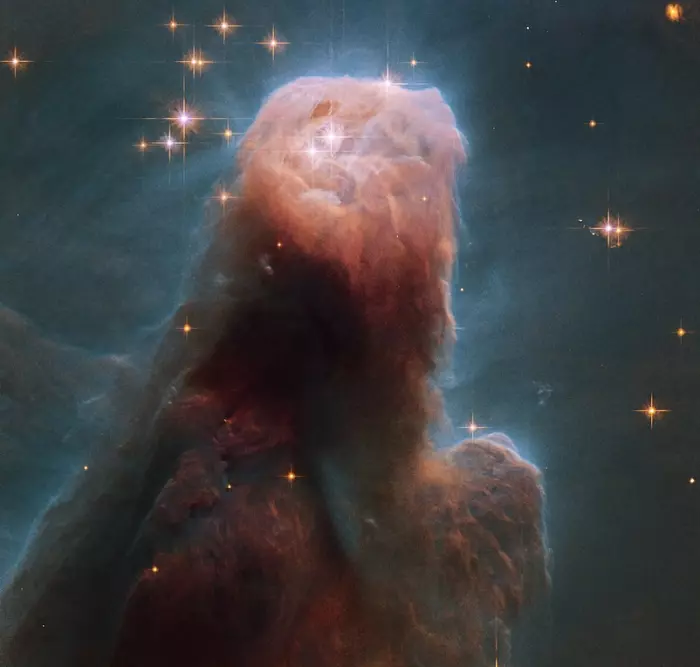
The Cone Nebula by the Hubble Space Telescope, credit: Judy Schmidt (CC BY 2.0)
The Cone Nebula is about 7 light-years across. It is faint when observed visually but makes a stunning sight in long-exposure photographs.
The nebula was named for its conical shape, which is the result of a dark nebula absorbing the light of an emission nebula that lies behind it. The dark absorption nebula is composed of dust and cold molecular hydrogen. The emission nebula in the background appears as a red halo of light around the edges of the dark cloud.
The faint emission nebula is ionized and illuminated by the star S Monocerotis, the brightest member of the NGC 2264 cluster. S Monocerotis (15 Monocerotis) is a massive variable star system that appears at the base of the Christmas Tree Cluster. It is the brightest star in the Christmas Tree.
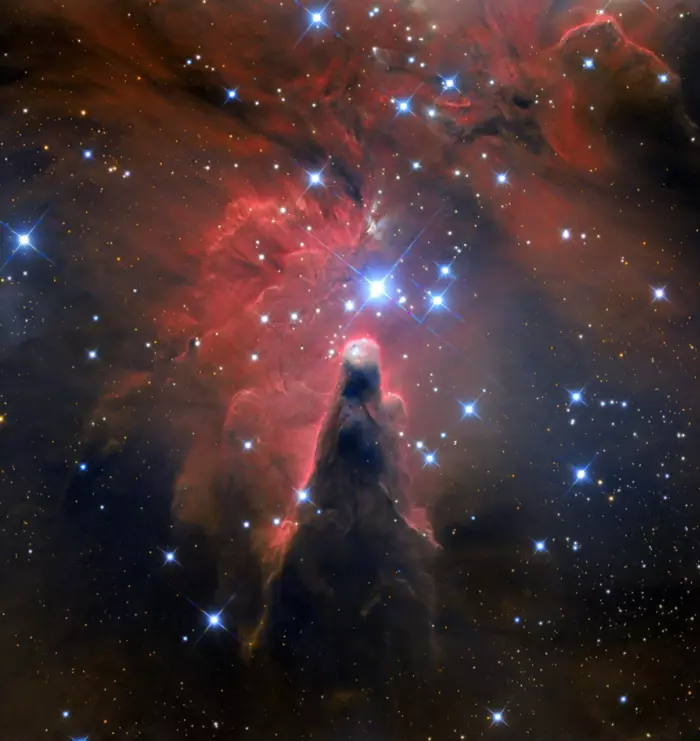
The Cone Nebula and the Christmas Tree Cluster, image credit: Adam Block/Mount Lemmon SkyCenter/University of Arizona (CC BY-SA 4.0)
The energetic winds from the hot young stars formed in the region erode the giant pillar of gas. The ultraviolet light of these newborn stars excites the hydrogen gas in the nebula and causes it to glow red. The blue light from nearby stars is reflected by the nebula’s dust and produces a blue glow in the patches of reflection nebulosity.
The Cone Nebula will eventually be eroded by the radiation of the new stars that form within it. Only the densest regions will be left, which may produce young stars and planets.
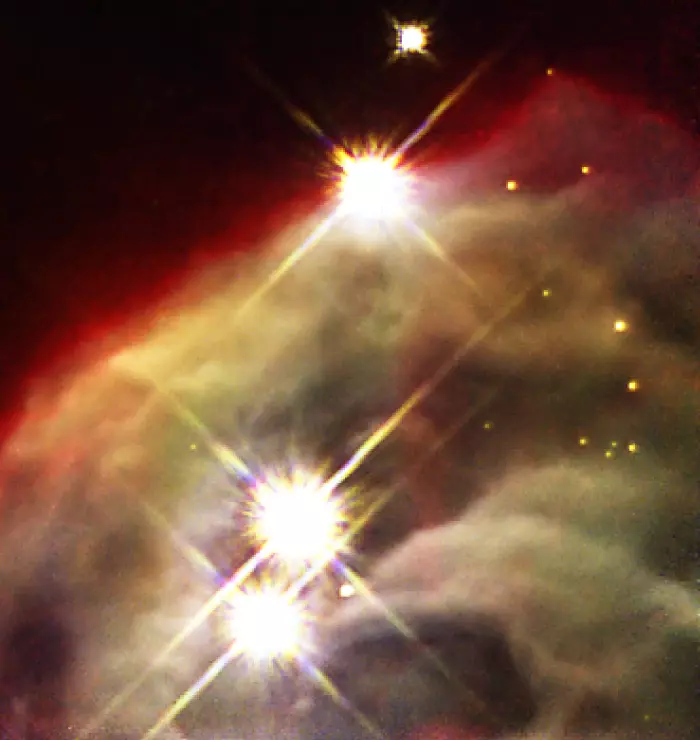
After astronauts repaired NICMOS – the Near Infrared Camera and Multi-Object Spectrometer – during the latest Hubble Space Telescope servicing mission, astronomers were quick to turn the sophisticated instrument on the photogenic stellar nursery known as the Cone Nebula. This remarkable NICMOS close-up of the Cone Nebula dramatically confirms that the Hubble’s infrared vision has been restored. Gas and dust clouds at the blunted tip of the cone-shaped star-forming region are seen here in false-color covering an area about half a light-year across. Toward the left hand side of the picture, the four bright stars with diffraction spikes are also present in visible light images and are in front of the Cone Nebula. But the fainter stars to their right are embedded in or behind the nebula’s obscuring dust clouds and are revealed only in this penetrating infrared view. Credit: NICMOS Group (STScI, ESA), NICMOS Science Team (Univ. Arizona), NASA
The nebula was likely sculpted by the strong stellar wind from the massive star NGC 2264 IRS. The star is embedded within the dust and gas of the nebula and cannot be seen by optical telescopes.
Hubble images taken in infrared light have revealed that the massive young star is surrounded by six very young, pre-main sequence stars with a mass almost that of the Sun, all found within less than a tenth of a light year of NGC 2264 IRS.
NGC 2264 IRS is sometimes called Allen’s source, after the astronomer D.A. Allen. In 1972, Allen discovered the object and pointed out that it was the likely source of the radiation pressure responsible for shaping the Cone Nebula. The star lies at the apex of the nebula.
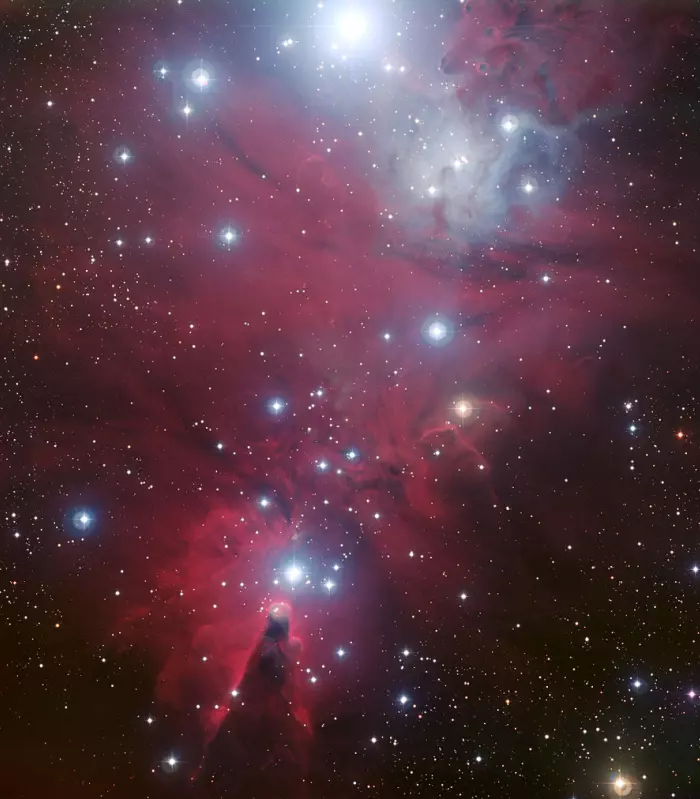
This colour image of the region known as NGC 2264 — an area of sky that includes the sparkling blue baubles of the Christmas Tree star cluster — was created from data taken through four different filters (B, V, R and H-alpha) with the Wide Field Imager at ESO’s La Silla Observatory, 2400 m high in the Atacama Desert of Chile in the foothills of the Andes. The image shows a region of space about 30 light-years across. Image credit: ESO (CC BY 4.0)
Facts
The Cone Nebula resembles the better-known Pillars of Creation, a star-forming region made famous by the Hubble image in 1995. The Pillars are located in the Eagle Nebula (M16) in the constellation Serpens. Pillar structures like these, formed of cold gas, are common in large regions of star birth. They are incubators for very young stars.
The Cone Nebula was discovered by the German-British astronomer William Herschel on December 26, 1785, almost two years after he had discovered the Christmas Tree Cluster. Herschel catalogued the nebula as H V.27.
The Cone Nebula is sometimes called the Jesus Nebula. Its shape resembles depictions of Jesus in prayer. It has also been nicknamed the Space Mountain.
In 2022, the Cone Nebula was photographed with the European Southern Observatory’s (ESO)’s Very Large Telescope (VLT) in Chile to mark ESO’s 60th anniversary. The image was obtained with the FOcal Reducer and low dispersion Spectrograph 2 (FORS2) on ESO’s VLT.
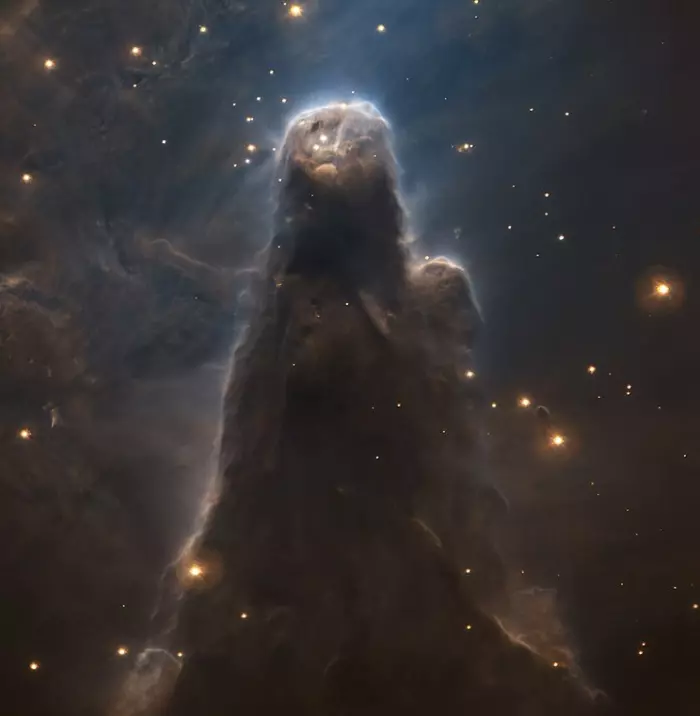
The Cone Nebula is a perfect example of the pillar-like shapes that develop in the giant clouds of cold molecular gas and dust, known for creating new stars. This type of pillar arises when massive, newly formed bright blue stars give off stellar winds and intense ultraviolet radiation that blow away the material from their vicinity. As this material is pushed away, the gas and dust further away from the young stars gets compressed into dense, dark and tall pillar-like shapes. This process helps create the dark Cone Nebula, pointing away from the brilliant stars in NGC 2264. In this image, obtained with the FOcal Reducer and low dispersion Spectrograph 2 (FORS2) on ESO’s VLT in Chile, hydrogen gas is represented in blue and sulphur gas in red. The use of these filters makes the otherwise bright blue stars, that indicate the recent star formation, appear almost golden, contrasting with the dark cone like sparklers. Image: ESO (CC BY 4.0)
Hubble Space Telescope image
The Cone Nebula was imaged with NASA and ESA’s Hubble Space Telescope in 1997. The image revealed young stars forming in the nebula.
The Hubble telescope also photographed the nebula in 2002. The Space Telescope Science Institute (STScI) released images of the nebula on April 30, 2002, to showcase the new high-resolution Advanced Camera for Surveys (ACS). The picture showed the upper 2.5 light-years of the nebula.
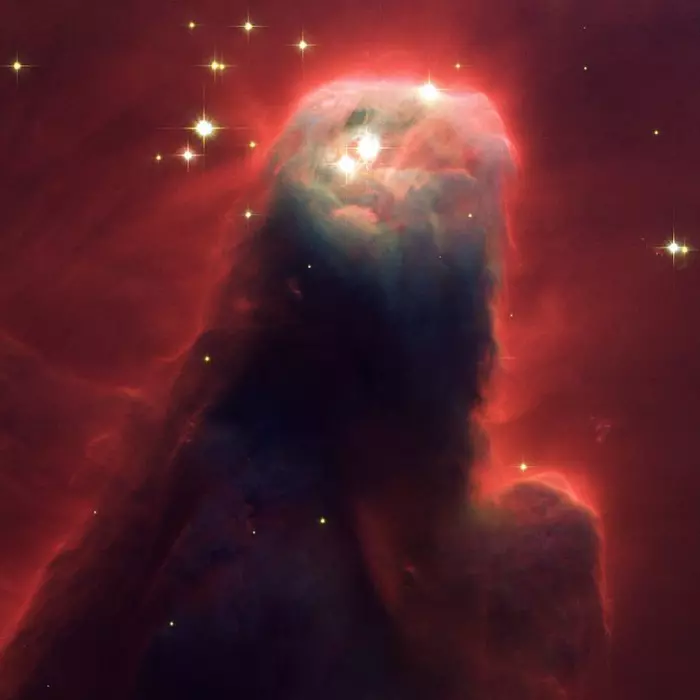
Resembling a nightmarish beast rearing its head from a crimson sea, this monstrous object is actually an innocuous pillar of gas and dust. Called the Cone Nebula (NGC 2264) — so named because, in ground-based images, it has a conical shape — this giant pillar resides in a turbulent star-forming region. Image credit: NASA, H. Ford (JHU), G. Illingworth (UCSC/LO), M.Clampin (STScI), G. Hartig (STScI), the ACS Science Team, and ESA
Location
The Cone Nebula is relatively easy to find because it lies in a region that contains many exceptionally bright stars. It is located in the northern part of the faint constellation Monoceros, north of the line drawn from Procyon in Canis Minor to Betelgeuse in Orion, and just south of the magnitude 3.35 star Alzirr (Xi Geminorum).
The nebula can be found by extending a line from Bellatrix through Betelgeuse. It can be seen in 10-inch and larger telescopes under dark skies.
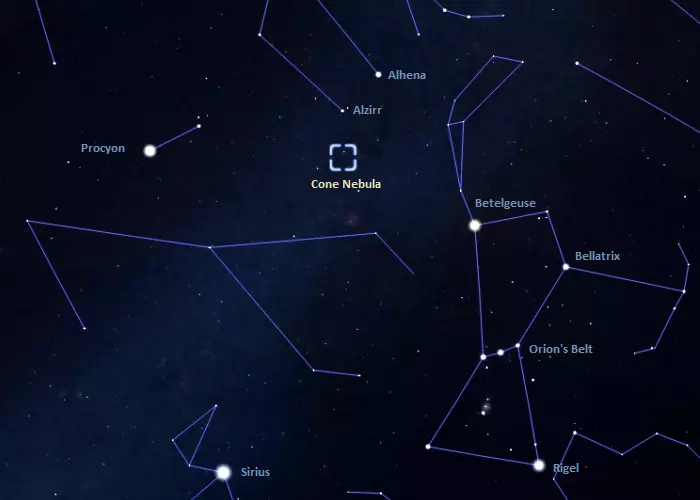
The location of the Cone nebula, image: Stellarium
The Cone Nebula appears in the same area of the sky as the larger and brighter Rosette Nebula. Several other notable deep sky objects appear closer to the nebula. The reflection nebula IC 2169, also known as Dreyer’s Nebula, is detached from the Cone Nebula but may be part of the same large molecular cloud. Two smaller reflection nebulae, NGC 2247 and NGC 2245, appear northeast of IC 2169.
The nearby NGC 2261, or Hubble’s Variable Nebula, lies 2,500 light-years away. It is a bipolar nebula about 2 arcminutes across, illuminated by the variable star R Monocerotis. Its name comes from the fact that, like the central star, the nebula varies in brightness over weeks and months.
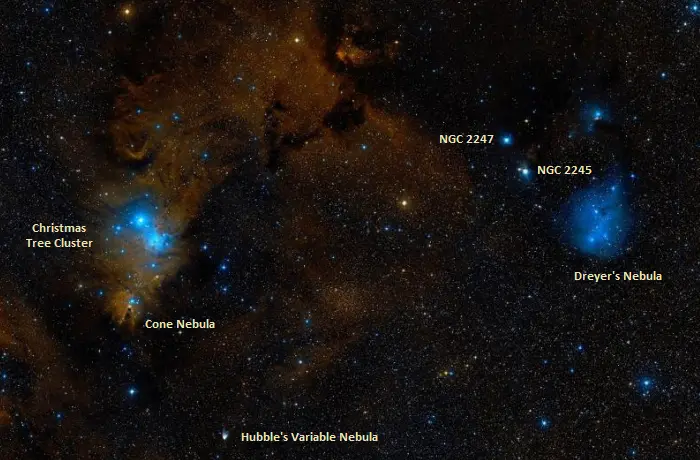
The Cone Nebula, the
Christmas Tree Cluster, Hubble’s Variable Nebula and Dreyer’s Nebula, image: Wikisky
The best time of the year to see the Cone Nebula, the Christmas Tree Cluster, and other deep sky objects in Monoceros is during the month of February, when the constellation rises higher above the horizon in the evening. Monoceros is an equatorial constellation and can be seen from most places on Earth for at least part of the year.
Cone Nebula
| Constellation | Monoceros |
| Right ascension | 06h 41m 15s |
| Declination | +09° 21′ |
| Apparent size | 3 arcminutes |
| Distance | 2,700 light-years |
| Radius | 4 light-years |
| Names and designations | Cone Nebula, NGC 2264 |